The new AMD’s new Ryzen Threadripper 3970X 32 core and TRX40 platforms are indeed nothing short of impressive. It is now time to review the MSI Creator TRX40 motherboard, which targets creative professionals. MSI has a platform that is going to appeal to many users that want lots of fast and relatively inexpensive cores along with features like PCIe Gen4 and plenty of expansion. In our review, we are going to take a look at the platform and how it performs.
MSI Creator TRX40 Motherboard Overview
The retail box for the MSI Creator TRX40 Motherboard is white, with logos printed at the center. Across the bottom, we find the AMD Ryzen logo and the motherboard type, in this case, a socket sTRX4.

The back of the retail box identifies product features and shows the rear IO ports at the bottom. If you are still making a purchasing decision at retail, this will help.
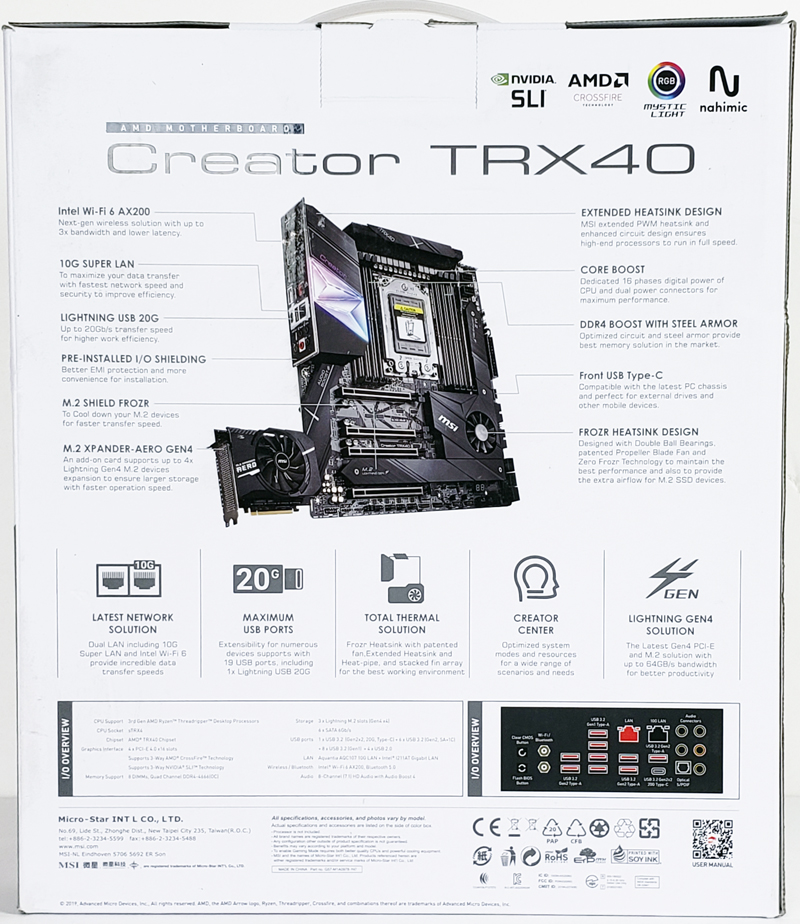
After taking the motherboard out of the box, we get our first look at the MSI Creator TRX40 Motherboard with its EATX 12” x 10.9” form factor. There are large M.2 NVMe heat sinks span the motherboard right side and bottom, that contribute to the overall look of the platform.

Looking at the underside of the MSI Creator TRX40 motherboard, we do not see a large metal plate to cover the motherboard back that we find in many motherboards these days. This would have been a nice feature to see as it helps make the platform more rigid and protects the motherboard during installation and handling.
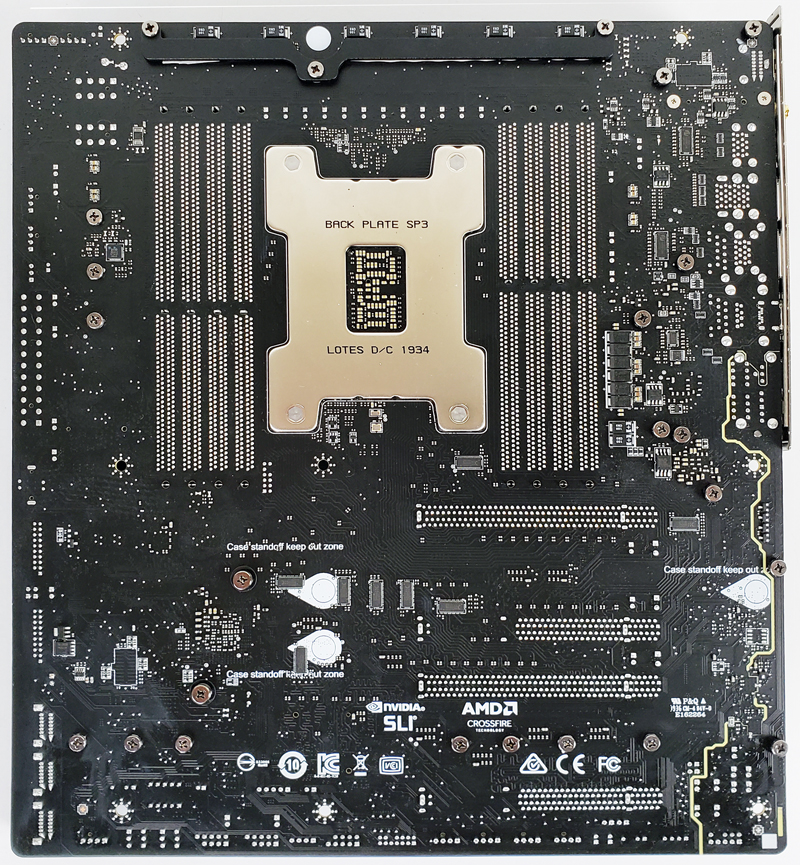
The AMD Socket sTRX4 is large and takes up a huge portion of motherboard space. Next to the sTRX4 Socket, we see 8x DDR4 memory slots that support up to 32GB x 8 for 256GB of memory. To aid with cooling, a long heat pipe between the RAM slots and M.2 heat sink connects the main VRM heatsink to the actively cooled chipset heatsink.
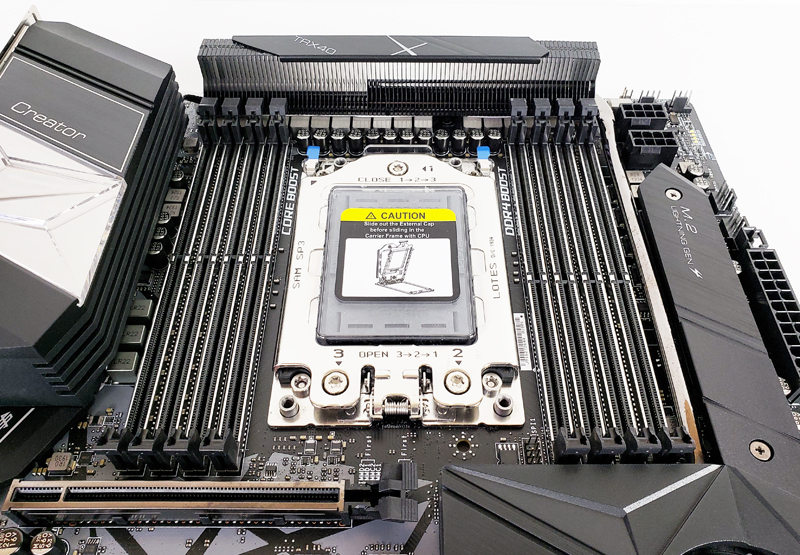
Storage connections at the motherboard edge are 6x SATA 3 6.0Gbs ports. Many motherboards have 8x SATA 3 ports. This is actually a bold choice by MSI as much as it is one for saving costs. These days, most high-performance storage is NVMe. For high-capacity, users in this class of system tend to use network storage. Given that 6 SATA III ports should be plenty for most users. We like that MSI is taking a more aggressive approach to the target market and saving cost where it will make sense for most users.

Power connectors consist of the 24-Pin at the edge and 2x 8-Pin connections a bit further inside.
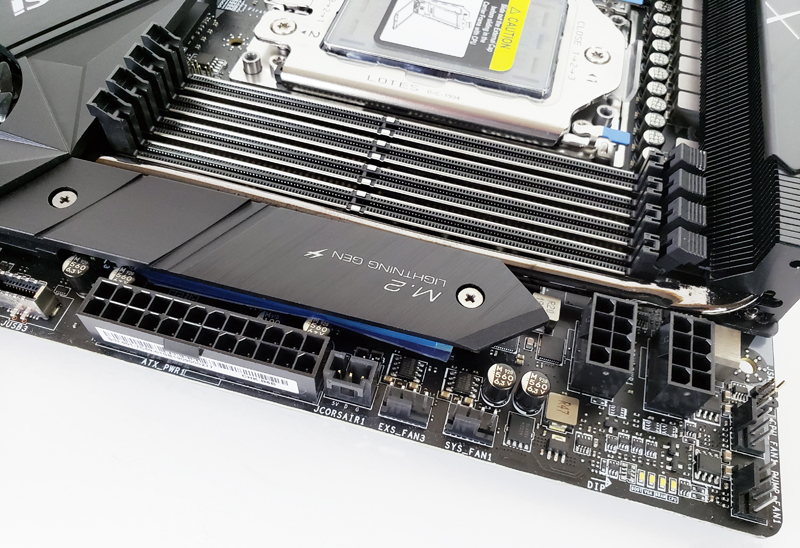
One item you can see in this photo is the plethora of 4-pin fan power headers. One item we may suggest as improvement is putting a 4-pin fan header near the rear I/O to make rear chassis exhaust fan installation easier.
Here we see the M.2 heat sinks removed to show the available locations. We find a total of 3x M.2 ports and thermal pads preinstalled for the top and bottom of the mounting locations. As we noted in our recent Corsair Force MP600 Review the presence of an onboard cooling solution means you will need to remove any heatsinks your PCIe Gen4 NVMe SSDs come with. Also, if you are using M.2 to U.2 adapters, you will not be able to put on the decorative covers.
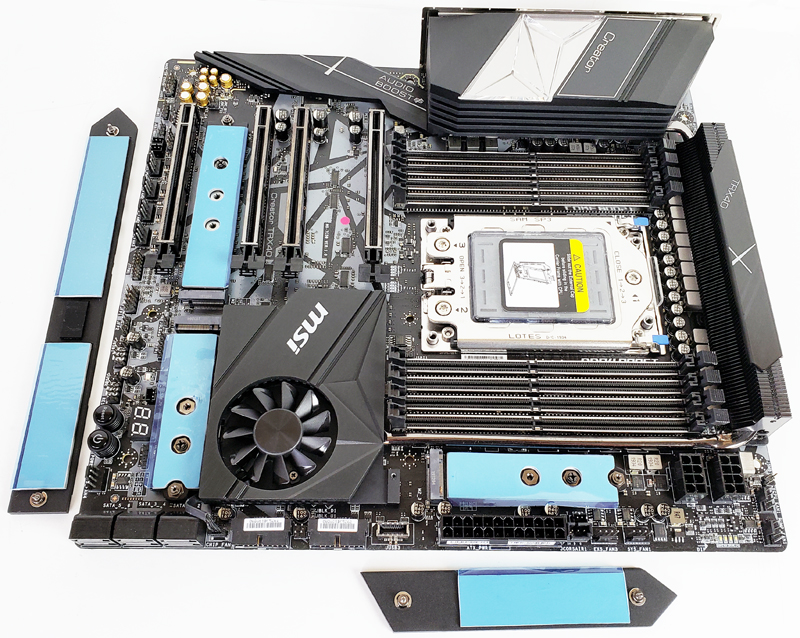
At the back of the MSI Creator TRX40 Motherboard, we find the rear IO ports which are:
- Clear CMOS Button
- Flash BIOS Button
- Wi-Fi Antenna Connectors for Intel Wi-Fi 6
- 2x USB 3.2 Gen2 Ports
- 4x USB 3.2 Gen1 Ports
- 1 Gigabit LAN Port (Intel)
- 2x USB 3.2 Gen2 VR Ready and Flash BIOS Port
- 10 Gigabit LAN Port (Aquantia/ Marvell)
- 1x USB 3.2 Gen2 Port
- 1x USB 3.2 Gen2x2 Type-C Port
- Audio Stack
The preinstalled I/O cover finishes up the back which is a feature we really like.

Overall there is a lot of I/O on the rear. One strange feature is the light outline around the 10Gbase-T port and extending to the USB-C port. The light outline makes the ports difficult to read. As an example, take a look at the 1GbE RJ45 label on the left above the port versus the label on the right RJ45 port. Contrast that white text on a light background to the red audio port on the far right of the I/O shield and you can see MSI changed the text to black text on a light background for higher contrast. This is a small feature, but one that would be easy to change in the future.
The MSI Creator TRX40 back IO heat sink cover has what MSI calls Mystic Light which cycles 16.8 million colors and 29 effects in a single click. For those who do not wish to use the feature, it can be turned off in the BIOS.
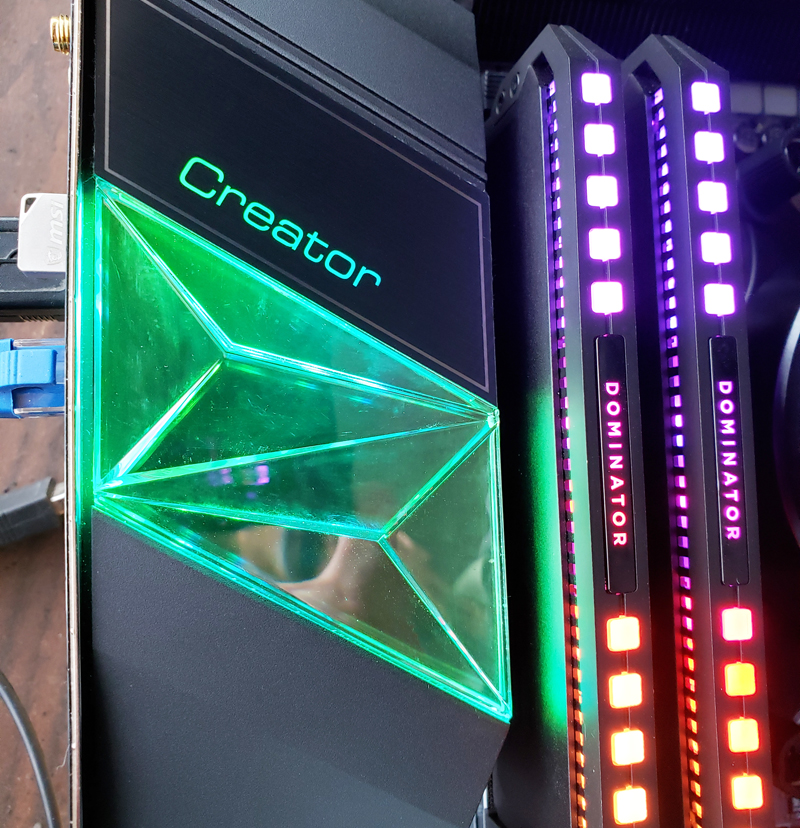
The retail kit includes a large number of accessories that break down as follows:
- User manual
- Quick installation guide
- An application USB drive with drivers & utilities 1
- 4x SATA 6G cables
- 1x LED JRGB Y cable
- 1x LED JCORSAIR cable
- 1x LED JRAINBOW cable
- 3x Thermal sensor cable
- 1x Expansion card M.2 XPANDER-AERO GEN4
- Wi-Fi antenna
- Case badge
- SATA cable stickers
- Product registration card
- 1x Bag of M.2 screws

At this level of a motherboard, we would have liked to see six SATA cables along with the six SATA ports. The Wi-Fi antenna is adequate, but something that many of our readers may look to improve on. One feature we did want to focus on is the M.2 Xpander Aero which is a clearly differentiating feature.
MSI Creator TRX40 M.2 Xpander Aero
Included with the MSI Creator TRX40 accessory loadout is the M.2 Xpander Aero PCIe card allowing for an additional 4x M.2 NVMe expansion slots.
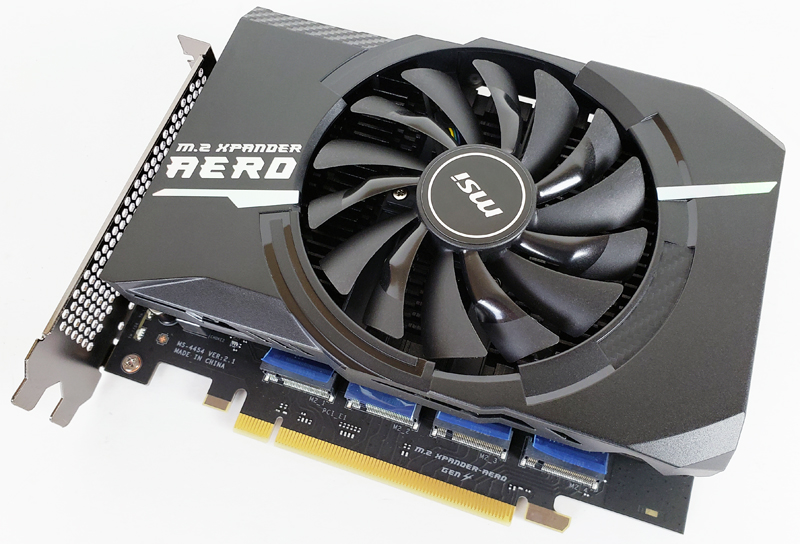
Removing the 4x mounting screws allows for the top case to be removed. A fan power cable connects the cover to the main PCB. Each M.2 slot has its own temperature monitoring strip and thermal mounting pads.
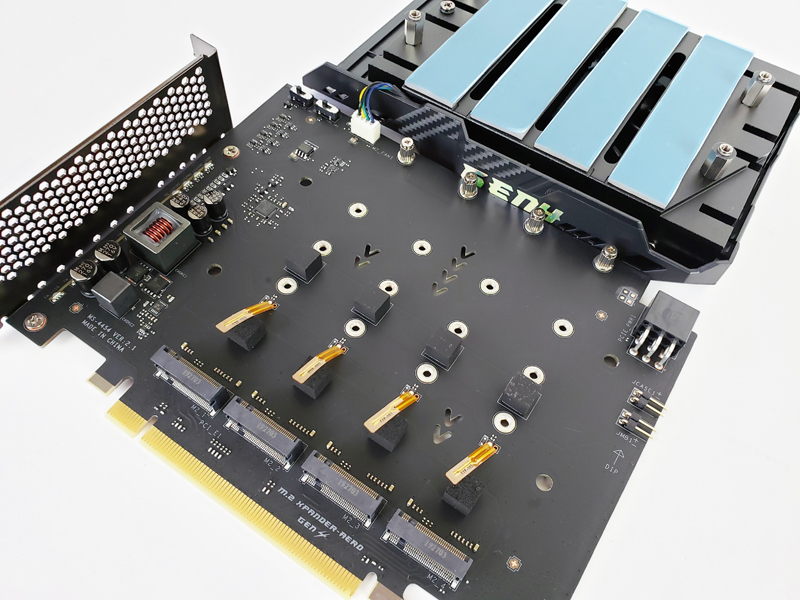
The card is taller than the PCIe bracket, so that is something to take into account in tight chassis configurations. Still, with this card one can utilize up to seven M.2 NVMe SSDs in the platform.
Before we get on with our testing, let us take a look at the MSI Creator TRX40 Motherboard BIOS and Software.


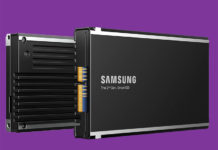


Many thanks, William: Please permit me to share one of my pet peeves about NVMe.
You will hopefully recall how multiple integrated SATA ports eventually became standard
with full support for all modern RAID modes. It is my sincere hope that motherboard
and storage vendors will make it an industry goal to integrate full BOOTABLE support
for all modern RAID modes for any number of integrated M.2 ports. We have had a
lot of success formatting SSD RAID-0 arrays with Windows drive letters C: / E: and
with D: typically assigned to a hard-wired optical drive. We will only upgrade to
a TR system, like this excellent MSI motherboard, unless we can do fresh OS installs
to a fast RAID-0 array of multiple M.2 NVMe drives. Because we also rely a lot
on large ramdisks in our workstations, we need a fast non-volatile partition
where the latest ramdisk contents can be saved at SHUTDOWN and then
restored quickly at the next STARTUP. The ramdisk software we are currently
using has a neat “block” logic, which only requires saving logical blocks which
have changed since the most recent STARTUP. Given the speed we anticipate
with Gen4 M.2 RAID-0 arrays, the STARTUP and SHUTDOWN sequences should
be so incredibly fast as to be almost unnoticeable! Thanks again. /s/ Paul
We currently have one of these boards with a 3960X and 7 FireCuda 520 PCIe 4 2TB drives. I have configured six of them in RAID 0. I can tell you it’s stupidly fast (>20gbps synthetic disk performance)!
I’d be curious to know what people think is the best memory option for this board.
Pity they didnt include BMC/IPMI..
@Aaron Do you know how to build Unreal Engine 4 from source? I would love to see how fast that ThreadRipper machine can build it. My 6 core machine takes 73 minutes for reference.
The board does not support out-of-box SR-IOV, I was able to enable it (after a couple of days of research) with a workaround for it in KVM (not sure it’s even possible in Windows virtualisation or VMWare).
MSI kindly agreed to build a custom BIOS to enable that but also stated that the feature will never make it into an official BIOS.
If you want SR-IOV, look elsewhere (or ask for a custom BIOS – assuming MSI will be willing to do it) and before you buy any TRX40 motherboard, ask the manufacturer.
The trouble with custom BIOS is that there’s no “tracking” – once it is issued, there’s no guarantee MSI will rebuild it when new official BIOSes are released.